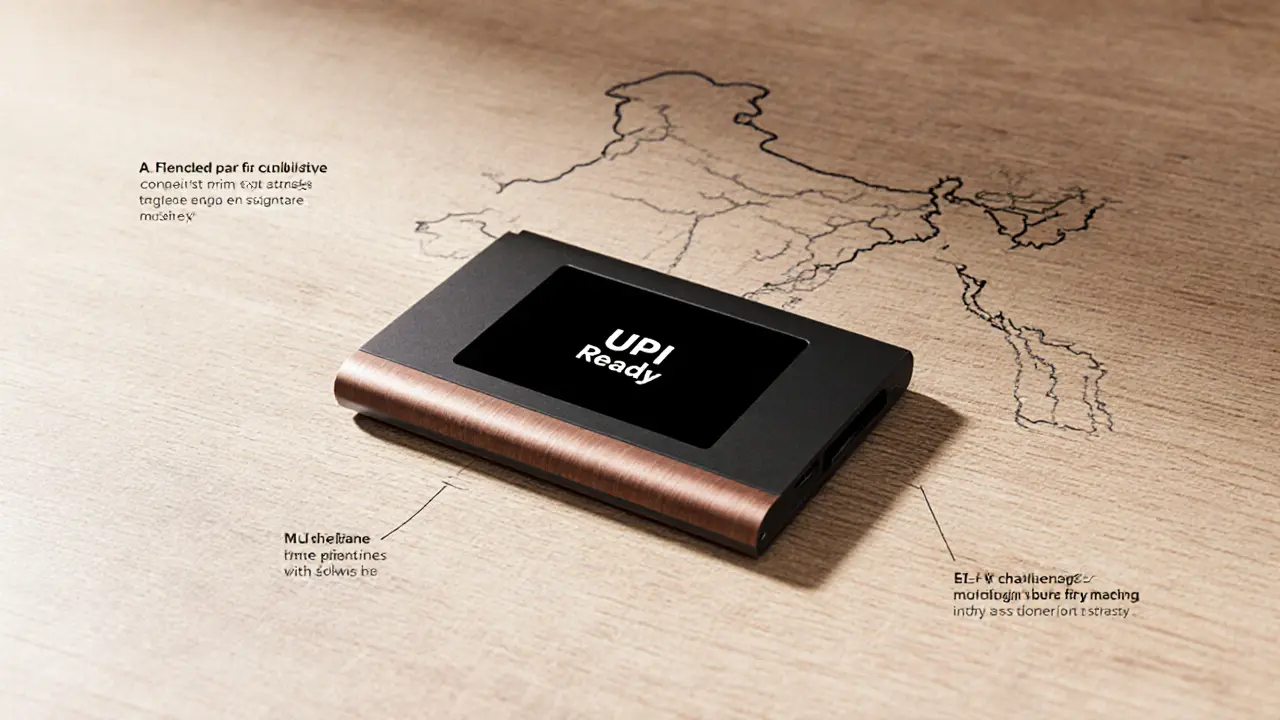Indian Crypto Exchange Selector
Recommended Exchange
India’s crypto boom shows no signs of slowing down, but navigating the market safely means choosing an exchange that supports Indian users, complies with local regulations, and offers the tools you need. Below is a curated list of the most reliable crypto exchanges for Indian citizens in 2025, complete with fees, payment options, and standout features.
Quick Overview
- CoinDCX - wide crypto selection, 0‑0.06% fees, UPI support.
- WazirX - Binance‑backed, 0.1‑0.4% fees, strong mobile app.
- Binance India - global liquidity, 0.10% flat fee, many payment methods.
- CoinSwitch - beginner‑friendly UI, 0.04% fees, UPI deposits.
- ZebPay - oldest Indian player, 0.15‑0.25% fees, lending options.
- Mudrex - portfolio‑style investing, 0.25% fee, automated strategies.
- Paxful - peer‑to‑peer, 1% seller fee, 350+ payment methods.
- Giottus - low‑fee tier, 0‑0.25% fees, 314+ cryptos.
Regulatory Landscape: What Every Indian Trader Should Know
Since the 2022 amendment to the Financial Services Law, Indian authorities require every crypto platform to implement strict KYC (Know Your Customer) and AML (Anti‑Money Laundering) processes. The central bank also mandates that exchanges must link deposits and withdrawals to Indian bank accounts using UPI, NEFT, IMPS, or RTGS. Choosing a compliant exchange reduces the risk of account freezes and protects your funds against fraud.
Detailed Look at the Leading Exchanges
CoinDCX
CoinDCX is India’s first crypto unicorn, offering over 200 coins, margin trading up to 5x, and a dedicated learning hub called DCX Learn. It charges spot fees ranging from 0% to 0.06% and supports UPI, IMPS, NEFT, and RTGS for INR transfers. Security‑focused features include multi‑signature wallets and partial insurance on stored assets.
WazirX
WazirX is a Binance‑owned platform serving more than 15million Indians, with 300+ crypto pairs and a P2P marketplace for instant INR settlement. Trading fees vary between 0.1% and 0.4% based on volume, and discounts apply for holders of the native WRX token. Deposits/withdrawals are instant via UPI, NetBanking, and IMPS.
Binance India
Binance India is the localized arm of the global Binance exchange, listing over 350 cryptocurrencies and 1,590 trading pairs. Spot fees are a flat 0.10%, and users can fund accounts through UPI, bank transfers, or debit cards. The platform adheres to Indian KYC norms while leveraging Binance’s deep liquidity.
CoinSwitch
CoinSwitch is a user‑centric exchange that evolved from an aggregator, offering a clean UI for buying 250+ assets with a 0.04% fee structure. It accepts UPI and traditional bank transfers, making the onboarding process especially simple for newcomers.
ZebPay
ZebPay is one of the oldest Indian crypto platforms, providing 217 coins, crypto‑lending services, and robust security measures. Fees range from 0.15% to 0.25% and it supports UPI, IMPS, NEFT, and RTGS for seamless INR movement.
Mudrex
Mudrex is a portfolio‑style investing platform that bundles cryptocurrencies into pre‑designed "Coin Sets" and runs automated strategies for users. It lists 669 assets, charges a 0.25% spot fee, and uses UPI and bank transfers for funding.
Paxful
Paxful is a peer‑to‑peer marketplace where Indian users can trade Bitcoin, Ethereum, USDT, and USDC directly with over 350 payment methods. Sellers pay a 1% fee, while buyers face no trading fee. Minimum deposit is about INR800.
Giottus
Giottus is a fast‑growing exchange offering 314+ cryptocurrencies, tiered fees from 0% to 0.25%, and 24/7 live chat support in multiple Indian languages. It supports UPI, NEFT, IMPS, and RTGS for INR transfers.

Comparison Table
| Exchange | Cryptos Offered | Spot Fee | Leverage / Margin | Supported INR Methods | Special Feature |
|---|---|---|---|---|---|
| CoinDCX | 200+ | 0%‑0.06% | Up to 5x | UPI, IMPS, NEFT, RTGS | DCX Learn Academy |
| WazirX | 300+ | 0.1%‑0.4% | 10x on futures | UPI, NetBanking, IMPS | P2P Marketplace |
| Binance India | 350+ | 0.10% | Up to 125x (futures) | UPI, Bank Transfer, Debit Card | Global liquidity |
| CoinSwitch | 250+ | 0.04% | None (spot only) | UPI, Bank Transfer | Beginner UI |
| ZebPay | 217 | 0.15%‑0.25% | None (spot only) | UPI, IMPS, NEFT, RTGS | Crypto lending |
| Mudrex | 669 | 0.25% | None (portfolio only) | UPI, Bank Transfer | Automated Coin Sets |
| Paxful | 4 (BTC, ETH, USDT, USDC) | 1% (seller) | None | 350+ methods incl. UPI | P2P escrow |
| Giottus | 314+ | 0%‑0.25% | None (spot only) | UPI, NEFT, IMPS, RTGS | Multi‑language support |
How to Choose the Right Exchange for Your Needs
- Trading style: If you want advanced charting and margin, CoinDCX Pro or WazirX are solid. For simple buy‑and‑hold, CoinSwitch or Mudrex work best.
- Fee sensitivity: Giottus offers 0%‑0.25% fees, while Binance India has a flat 0.10% fee but may charge network fees on withdrawals.
- Payment convenience: All major platforms accept UPI; however, Paxful stands out with 350+ payment options like gift cards.
- Security & insurance: Look for multi‑signature wallets, regular proof‑of‑reserves, and any asset‑insurance coverage (CoinDCX provides partial insurance).
- Customer support: Exchanges offering support in Hindi, Tamil, Telugu, and Marathi (WazirX, Giottus) tend to resolve issues faster.
Step‑by‑Step: Getting Started on an Indian Crypto Exchange
- Pick an exchange that matches your trading style and fee tolerance.
- Visit the official website or download the official app from Google Play or the Apple App Store.
- Click “Sign Up” and enter your mobile number (use the Indian format +91‑xxxx‑xxxx).
- Complete KYC: upload a government‑issued ID (Aadhaar or PAN) and a selfie for facial verification.
- Link a bank account or activate UPI for INR deposits. Most platforms verify the bank link instantly.
- Deposit INR via UPI, NEFT, or IMPS. Funds appear in seconds for UPI, a few hours for NEFT.
- Navigate to the “Buy Crypto” or “Spot Market” tab, select the coin, enter the amount, and confirm.
- Store your assets: keep small amounts on the exchange for trading, and move larger holdings to a hardware wallet for long‑term security.
Frequently Asked Questions
Can I use any global exchange as an Indian citizen?
Most global exchanges (e.g., Coinbase, Kraken) block Indian IP addresses for compliance reasons. Using a localized or India‑friendly platform ensures smooth KYC, INR deposits, and avoids account freezes.
Is UPI the best way to fund my crypto account?
Yes. UPI transfers settle instantly, have low transaction costs, and are supported by every major Indian exchange listed here.
Do Indian exchanges insure my crypto holdings?
Only a few, like CoinDCX, offer partial insurance for assets held in hot wallets. Most rely on robust security protocols and recommend moving large sums to personal hardware wallets.
Which exchange has the lowest fees for frequent traders?
Giottus offers a 0% maker fee tier for high‑volume traders, while CoinDCX drops to 0% for VIP users. Binance India’s flat 0.10% fee is predictable but not the cheapest at very high volumes.
Can I trade on multiple exchanges simultaneously?
Absolutely. Many Indian traders use a “best‑of‑both‑worlds” approach: they keep a small amount on a low‑fee spot exchange for day‑trading and a larger portfolio on a P2P or portfolio‑focused platform like Mudrex.

